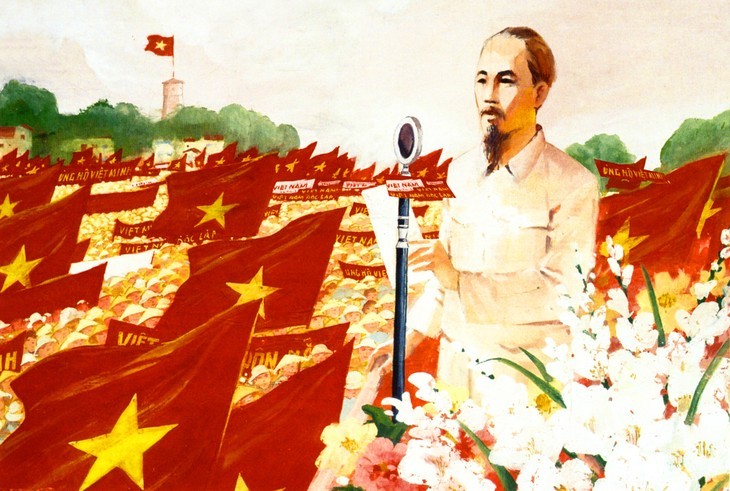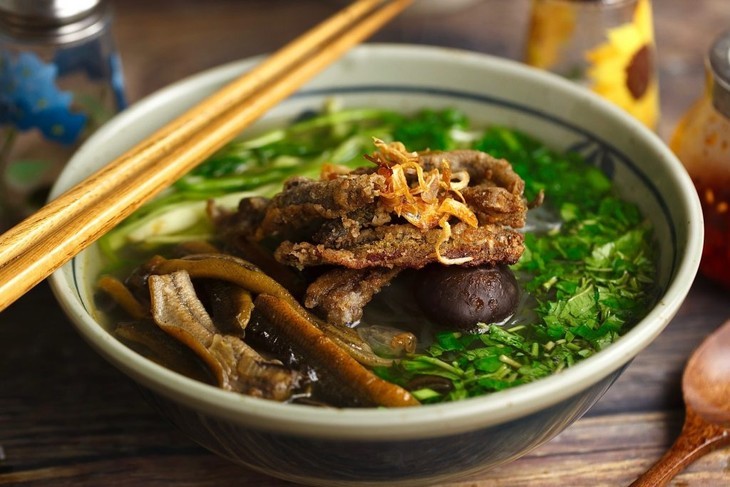 On September 2, 1945, President Ho Chi Minh read the Declaration of Independence, establishing the Democratic Republic of Vietnam, now the Socialist Republic of Vietnam (Photo: chinhphu.vn) On September 2, 1945, President Ho Chi Minh read the Declaration of Independence, establishing the Democratic Republic of Vietnam, now the Socialist Republic of Vietnam (Photo: chinhphu.vn) |
B: In their correspondence to VOVWorld this week, most Chinese listeners discussed the development of the Vietnam-China relationship as Vietnamese Party leader and President To Lam paid a State visit to China at the invitation of Chinese Party leader and President Xi Jinping.
A: As Vietnam is celebrating the 79th anniversary of the August Revolution and National Day on September 2, many listeners sent us congratulations and greetings.
B: We’d like to thank Armando Francisco Higuera del Reyo of Mexico, for his thoughtful reflection on the significance of the August Revolution of 1945. He wrote: “ Indeed, this historic uprising paved the way for Vietnam's independence, a milestone that continues to inspire Vietnamese people today under the leadership of President To Lam.”
A: It is heartening to know that this event is also celebrated in Mexico, alongside freedom-loving people around the world.
B: We also appreciate the correspondence from Juan Diez of Spain, who highlighted the simultaneous victories of the August Revolution in Vietnam and the Soviet Union's triumph in the Great Patriotic War. He wrote: “These events connected the two outstanding politicians Lenin and Ho Chi Minh and strengthened the solidarity between the two states and two nations.”
A: A special thanks to Juan Franco Cresco from Tarragona, Spain, for your kind words about Vietnam's growing prominence in the semiconductor chip industry. Your congratulations and well-wishes for our continued success in this field are greatly appreciated.
B: Kai Motofumi of Japan asked: “Currently in Japan, many young people have established green funds to promote a clean and green environment. I see numerous activities being carried out both in the media and through field trips, as well as extensive awareness campaigns in schools. I wonder how similar initiatives are being implemented in Vietnam?”
A: In Vietnam, environmental protection and sustainability are gaining increasing attention, especially among the younger generation. Various organizations and student groups have launched initiatives similar to Japan’s green funds, focusing on raising awareness and encouraging eco-friendly practices.
B: Activities such as tree planting, clean-up campaigns, and educational workshops are regularly organized. These efforts are also well-supported by the media and integrated into school programs, fostering a culture of environmental responsibility among young people in Vietnam.
A: Matsumoto Takuya of Japan shared his interest in our stories about Vietnam’s land, people and culture. He told us that he would like to hear about Vietnamese street food.
B: Vietnam is famous for its vibrant street food culture, with dishes like pho, banh mi, and bun cha being popular favorites. Street vendors can be found on almost every corner, offering a variety of flavors that reflect the rich culinary heritage of the country. Whether it’s a quick snack or a full meal, Vietnamese street food is a must-try for anyone visiting the country.
A: In its suggestions for two days in Hanoi, Michelin Guide has suggested several street dishes including Pho Bo or beef noodle soup, banh cuon or steamed rice rolls, mien luon or eel glass noodle, cha ca or grilled fish noodle, and bun cha grilled pork noodle.
B: Michelin Guide said street food is a competitive business in Hanoi and that the Old Quarter is the best place for foodies to stay. Not only does it have the best street food, but the neighborhood is also packed with temples, pagodas, churches, lakes, parks and cafes. In other words, this is the ideal place to spend time before your next meal.
A: Just take a few minutes to explore the recipes of eel glass noodle which is delicious and can be eaten at any time of the day because it is light, but still nutritious.
B: Bui Thuy Ngan, who has been serving eel glass noodle in Hanoi for more than 20 years, shares her experience in preparing the ingredients.
"The eel should not be too big or too small and should be fresh. Wash the eel first. Separate the bone from the meat. The bone can be used to make broth, and the flesh can be fried or stir-fried." said Ngan.
 (Photo: savory.vn) (Photo: savory.vn) |
A: The water should be boiled with some salt. Then scald the eels. The boiled water and salt help get rid of the fishy smell of the eels. But, the water shouldn’t be boiled too much, or it will break the eel skin. When the eel is clean, it is ready to fry.
Ngan said: "Before frying, the eels are coated with corn starch, which keeps the eel shape while they are being fried. First, pour oil into a frying-pan. Heat the oil, then fry the eels for 15 minutes. You need to divide the eels into batches, each batch about half a kilo. Remember to use a pair of chopsticks to separate the eels while frying."
B: When the eels turn golden brown and crunchy, it’s the time to remove them from the oil. So yummy. But you know, eels can be made in a soft version to cater for different tastes. For the soft version, the eels are cleaned the same way as the crunchy ones. Then, Ms. Ngan stir-fries them with some seasoning and shallots.
A: We should focus on the broth, which is the soul of any kind of soup. Ms. Ngan said: "For eel glass noodle soup, we have to prepare broth. We simmer pig and eel bones together. Add grilled shallots and ginger to enhance the flavor. When the bones are well-cooked, add mushrooms and citronella. Finally, adjust the taste of the broth."
B: We hope you know now how to make eel glass noodle soup. I think I can finish the final step. First, cook the glass noodle soup broth. Then, place glass noodles in a bowl, top the noodles with crunchy or soft eels, fried shallots, and some herbs, such as sliced spring onions and sliced coriander. Finally, pour in the broth. Some people prefer to serve it with spices like pepper, or chilli and vinegar.
A: We hope that our dear listeners will visit Vietnam one day or can cook some Vietnamese dishes with our recipes.
B: Indonesian listener Fachri asked about the Mui Ne sand dunes, their distance from Hanoi, and whether they are a tourist destination. Mui Ne, located in the south of Vietnam, is famous for its stunning sand dunes, which are about 1,500 kilometers from Hanoi and 190 km from HCM City.
A: These dunes, especially the white and red sand dunes, are popular tourist attractions, offering unique landscapes that are perfect for activities like sandboarding and dune sledding. The area is also known for its beautiful beaches and is a favorite destination for both local and international tourists.
A: We’d like to welcome Guido Panebianco from Italy, who listened to our program on the frequency of 11885 kHz on August 17. He wrote: “I really appreciated the Vietnamese music transmitted in the last part of the program, especially the song about coffee in the Central Highlands sung by Siu Black.”
A: He continued: “ Greetings from the isle of Sicily, in Italy! Here is summer, a very hot summer, and the Etna active volcano, which is near the city where I live, is giving some troubles smoking, and this smoke provokes some ash rains in Catania!”
B: Thank you, Guido Panebianco, for tuning in to VOV. We hope to continue to receive more feedback from you. Ridika Ridi of Bangladesh listened to our broadcast on August 22 on the frequency of 7220 khz and shared his interest in listening to our broadcasts about current affairs in Vietnam.
A: We’d like to acknowledge correspondence from Sahadot Hossain, Adiba Ava, and Abdul Mannan of Bangladesh, Muhammad Aqeel Bashir of Pakistan, Bidhan Chandra Sanyal and Ratan kumar Paul of India.
B: Thank you all for your interest in VOV. We welcome your feedback at English Service, VOVWORLD, the Voice of Vietnam, 45 Ba Trieu Street, Hanoi, Vietnam. Or you can email us at englishsection@vov.vn. You’re invited to visit us online at vovworld.vn, where you can hear both live and recorded programs. Once again, thank you all for listening. Goodbye!